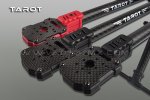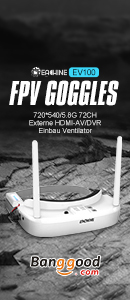Es ist keine gute Idee die ESC's mehr als 200mm von der Batterie entfernt zu haben.
Ich hatte plötzliche Stotterer und unerklärliche Motor ausfälle.
Ich hatte alle moegliche Probleme, und habe dann diesen Bericht gefunden.
Ich habe ihn erst nicht gepostet weil er auf Englisch ist und ich ihn kopiert hatte, aber den Link verloren habe.
Vielleicht hilft es aber trotzdem jemanden:
Well as one who has actually measured the back-emf pulses in battery leads I would have to disagree. I was asked to perform precisely this experiment by an importer last year, because he was being sued by a customer for the cost of four £90 speed controllers (plus consequential damage) that he had fitted into a TN Lanc (the big one). He'd fitted the controllers adjacent to the motors and put the batteries in the bomb bay. 30 seconds into the first flight two of the controllers failed within a couple of seconds of eachother, and the remaining two failed (again within a couple of seconds of eachother) about 10 seonds later as he tried to bring it back. Unfortunately the model went into trees and was a complete write off, damaging several servos and the Rx as well - the customer was claiming a total of £1200.
The instructions supplied with the controllers stated "max battery to lead length 200mm", but the user had used lead lengths of between 800 and 1400mm.
The importer gave me four controllers - one of the original type (a "blue chip" brand, one of another "high cost" brand (Jeti) plus two "budget" ones. All were rated at over 60A, with the budget ones being 100A ratings in deference to their suppliers' advice that they be derated. The tests were conducted at 24v into the controllers using a lead-acid car battery (because I didn't want to wreck a perfectly good lipo should anything fail short-circuit), ramping up to 55A for the tests using an Axi 4120/18 driving a 14-8 prop as the load. Lead lengths from 2000mm to 200mm were used, in 200mm increments plus a few other lengths.
The initial tests were exploratory, setting a notional voltage limit of 100v and finding the shortest lead length at which this voltage was not exceeded at half throttle (starting with the longest lead, testing each controller and then cutting the leads down for the next group of tests - I went through a lot of solder that day!).
It is interesting to note that the observed back-emf pulses were essentially identical with all four controllers, indicating that they all had pretty similar input capacitance. This would suggest that their ability to withstand back-emf pulses was solely down to the characteristics of the MOSFETs used. Tests were observed by the importer and the customer.
From the initial tests we discovered that the longest length at which the back-emf pulses remained below 100v** was around 250-270mm. By inserting additional capacitors we found we could extend this to 500mm and 1000mm, but above that we started getting ringing in the cables so we stopped. We also found that with the additional capacitors fitted there was ringing in the cables if they were short - ie a specific level of capacitance only worked over a specific cable length.
Extended motor runs were then perfomed using each controller at 55Amps for five minutes, demonstrating that the controllers were able to drive the load on 200mm cables.
On the basis of these findings the importer then suggested we try a durability test "to destruction if necessary" with the cables at 800mm and no capacitors. An initial test found that at 55A in this configuration the 1msec pulsewidth was at 430volts. We proceeded to run the test and after 74 seconds (on the original blue-chip controller) the controller vented smoke and died. We then switched to 1400mm cables and repeated the test with the Jeti controller; the pulse voltage was over 700volts and the controller expired after 18 seconds. The tests were repeated with the two budget controllers (one at each cable length) giving numbers of 43 and 14 seconds respectively.
After witnessing the tests the customer withdrew his claim. As a gesture of goodwill the importer decided not to bill the customer for the cost of the controllers consumed, and I then felt that I had to waive my previously agreed fee for the four hours of work
Now every installation is different, and the cable inductance may have bigger effects in some installations than others which is probably why many people have reported "getting away with it". But the 200mm figure is stated by the manufacturers for good reasons, and if you elect to ignore it you're on your own!
£0.02 supplied, YMMV,
PDR
**EMF pulses are not "square"; they are a sharp-edge followed by a decay. Based on advice from the EMH engineer at the office we set this threshold as "the point at which the pulse was above 100v for 1msec" because apparently a 1msec pulse was long enough to damage a MOSFET



